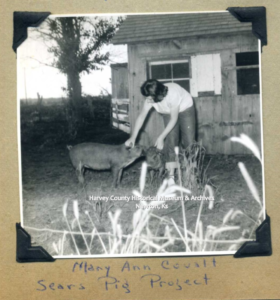by Kristine Schmucker, HCHM Curator
History is full of tiny, yet interesting stories. Such is the case of the “Sears Pig.” Recently, I gave a presentation in partnership with the Newton Public Library, Tales & Tails: Usual & the Unusual Pets. One 4-H photo featured a young woman with her Sears Pig Project. I had not had time to research this, so I asked if anyone knew about this project. The next day I had some good answers from friends listening to the program.
Sears-Roebuck 4-H Pig Projects
The “Sears Pig” was part of unique program was popular in the 1940s-60s often known as a “livestock chain.” 4-H and FFA Clubs were active participants in the educational program. The Sears-Roebuck Plan selected ten 4-H Club members in a county who were given purebred pigs. They raised and bred the animals and gave one pig from their first litter to the organization. The ten animals given to the county agricultural agent would then be placed with ten more student participants.
They also participated in county showing and judging events with small cash prizes.
This enabled the young people to build their own stock.
Although support for these programs came from several sources, the most notable was the Sears-Roebuck Foundation. Sears provided animals and funding to support the livestock chains throughout the country. At one point Sears had 1,253 swine programs in operation all across the country.
There were also other livestock chains including poultry, dairy calf, beef heifer, and bull chains.
Sources
- The Friday Footnote: Livestock Chains (5/3/2019) https://footnote.wordpress.ncsu.edu/
- Hurford, David D. “The Sears-Roebuck Foundation: A business history of the Sears, Roebuck public relations program, 1950-1960.” Master’s Thesis, Business Administration, 1962. University of Southern California. http://digitallibrary.usc.edu/digital/collection/p15799coll26/id/310268


